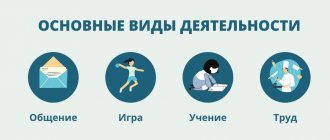Great Army. Start of the hike
Having carefully prepared, Napoleon launched an invasion of Russia. He could not even imagine what catastrophe awaited him ahead. Beginning on June 11, 1812, the advanced units of Napoleonic army began crossing the Neman and Bug rivers in different places. Napoleon's army had a total strength of more than 600 thousand people; such a number of troops could not be assembled in one place, so the French acted in several directions.
Napoleon's strategic plan was to defeat the main forces of the Russian army in one, maximum two general battles. This is what he tried to accomplish. The Russian army was not inferior to Napoleonic's in terms of combat effectiveness, but was three times inferior in numbers; moreover, bad roads and long distances did not allow combining common forces together.
Barclay de Tolly, who commanded the 1st Army at the time of the invasion, was in the Baltic region, the 2nd Army was commanded by Bagration, which was in western Belarus. The decision was made to unite the two armies together. Napoleon understood that it would be easier to defeat the scattered enemy forces, so he tried with all his might to do this.
The two Russian armies retreated, avoiding major battles, but at the same time it was not a disorderly flight; they had to constantly repel attacks by large enemy units, who tried with all their might to prevent the connection of the two armies. Near Smolensk on August 3, 1812, the two armies united together, this was the first strategic victory.
Barclay de Tolly was appointed commander of the united army; he was not a supporter of a general battle, and his position had serious reasons for this. In the event of defeat, it would not be possible to equip a new combat-ready army, since in Russia at the beginning of the 19th century the current recruiting system did not allow this to be done in a short time.
They decided to retreat in the Moscow direction, leaving Bagration’s army of 34 thousand people as cover. Bagration restrained Napoleon's army storming Smolensk, and the main forces retreated in an organized manner without losses.
Prerequisites and the beginning of the Patriotic War
In 1807, Russia concluded a peace treaty with the Emperor of France Napoleon I, called the Peace of Tilsit. According to this agreement, Russian Emperor Alexander I pledged to participate in the continental blockade of England.
Napoleon had to withdraw troops from Prussia , which bordered Russia. Neither party fulfilled the terms of the agreement. Alexander I signed an agreement on neutral trade, thereby abandoning the blockade of England, in turn, the Treaty of Tilsit gave Napoleon a free hand, which allowed him to occupy all the states of Europe. Only England retained independence, and only Spain continued to stubbornly resist the invaders. All this allowed Napoleon to move his troops close to the borders of the Russian Empire. War was inevitable.
Napoleon understood perfectly well that he had a serious opponent in front of him. Preparations for the war were carried out very carefully. Large reserves of food and ammunition were created near the borders with Russia. French intelligence was actively collecting information about the potential enemy.
An attempt was made to undermine economically by throwing out counterfeit money. Russian diplomacy took retaliatory steps. Secret agreements were concluded with a number of European states that did not want to fight for other people's interests. They pledged to provide minimal support to Napoleon.
Victory Day is one of the most important Russian holidays: on May 9, we forget about all differences and remember that we are one people. This holiday concerns every resident of the country, it unites generations and makes everyone feel like they are part of something important. Unfortunately, every year there are fewer and fewer veterans of the Great Patriotic War, and soon our children will be able to learn about the feat of the generation of our grandparents only from our stories and history lessons. At the same time, with the development of the Internet, more opportunities have appeared to recreate and preserve the history of this national feat.
"Feat of the people"
Public electronic bank of documents “Feat of the people in the Great Patriotic War of 1941-1945.” (podvignaroda.ru), created with the support of the Ministry of Defense of the Russian Federation, contains reliable information about the progress and results of major combat operations, the exploits and awards of all WWII soldiers.
Sources of information are the funds of the Central Archive of the Ministry of Defense of the Russian Federation (CA MO), including the Archive of Award Cases with documents on 30 million wartime awards and the Archive of Documents on the Operational Management of Combat Actions.
Among the stated goals of the podvignaroda.ru project is to perpetuate the memory of all heroes, regardless of rank, the scale of the feat and the status of the award, as well as the creation of a factual basis to counter attempts to falsify the history of the Second World War.
Thanks to this unique resource, everyone can find information about military operations, the geography of military operations, wartime awards, and also see historical documents with their own eyes. Here you can also get information about the storage location of paper originals of archival documents for each soldier.
OBD Memorial
The generalized database OBD Memorial (obd-memorial.ru), created by the Ministry of Defense of the Russian Federation, contains information about the defenders of the Fatherland who died and disappeared during the Great Patriotic War and the post-war period.
Until now, even after many decades, the fates of thousands of people remain unclear. The search for the burial places of the fallen soldiers is still ongoing. The main goal of the obd-memorial.ru project is to help people find out the fate of their dead or missing relatives and friends, and find information about burial places.
As part of the project, more than 13.7 million sheets of archival documents, over 42 thousand passports of military graves and more than 1000 volumes of the Book of Memory have been preserved in electronic form. The main body of documents are reports from combat units about irretrievable losses and other archival documents clarifying losses (funerals, documents from hospitals and medical battalions, captured cards of Soviet prisoners of war, etc.). Work to replenish the data bank continues.
On the website you can find information about the rank of the deceased, the unit in which he served, the date and cause of death (killed, died of wounds, missing) and burial place. Scanned copies of all processed source documents are posted here. These documents make it possible to identify dead soldiers with great accuracy, since they often contain additional information, in particular, the names and addresses of relatives to whom the funeral was sent.
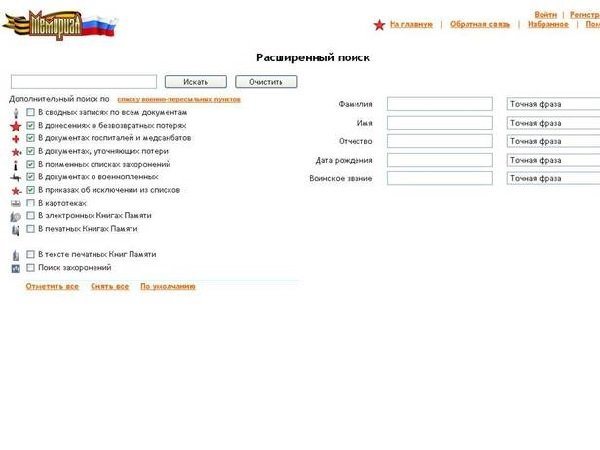
"Remember us"
The database of monuments, memorials, military graves of WWII soldiers “Remember us” (pomnite-nas.ru), created by enthusiasts in 2006, today contains information about more than 11 thousand monuments with 36 thousand photographs. The creators of the project encourage site visitors to send photographs of monuments, memorials or graves of unknown soldiers, taken in various parts of Russia and abroad.

"I remember"
The “I Remember” project (iremember.ru) contains the memories of WWII veterans: tank crews, pilots, scouts, snipers, sappers, partisans, doctors - those who survived those terrible years. Here you can read the memoirs of WWII participants, listen to fragments of audio recordings of conversations with veterans, view scanned copies of letters from the front and a photo album with photographs of the war years.
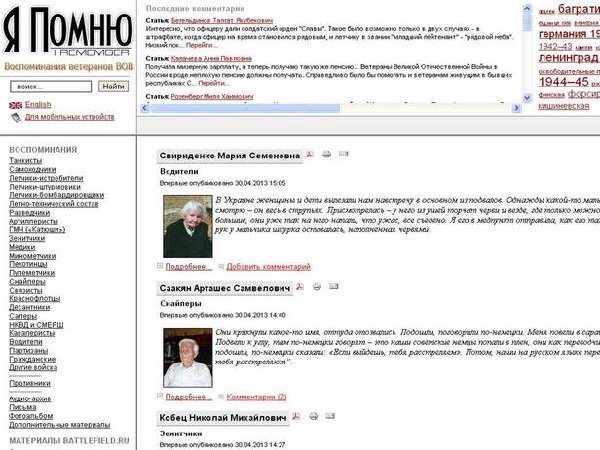
"Our common Victory"
The all-Russian project “Our Common Victory” is a video archive of memories of veterans of the Great Patriotic War, formed by volunteers, which will subsequently be transferred to the State Archives of the Russian Federation.
As planned, the video archive will allow us to preserve for history the “living” memories of representatives of the generation that is leaving us forever: their emotions, feelings, pain, fear, bitterness of loss and the incomparable joy of the Victory and pride in the heroism of the people.
Anyone can take part in the project, created with the support of government bodies and public organizations. To do this, you need to record a video interview with a WWII veteran and post it on the website. All added videos are sorted by city, rank, front, branch of service, battle.
In addition, as part of the project, a specialized mobile application for iPhone and iPad has been created, which allows you to shoot a video memory of a WWII veteran on the device’s camera and publish it on the website of the “Our Common Victory” project.
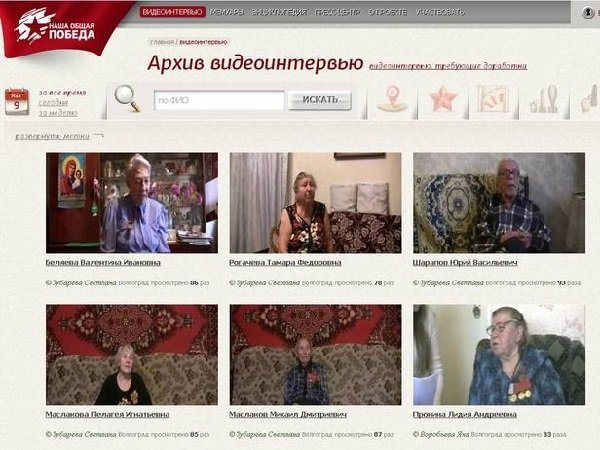
Military literature
The website "Military Literature", also known as Militera, contains diaries and letters, memoirs and biographies of WWII participants. Primary sources, valuable for specialists and anyone interested in military history, are found here side by side with fiction about the war.
The “Military Literature” project is non-profit: all texts presented here are intended for free reading by everyone. Any text or book can be downloaded in the most popular formats for reading on mobile devices.
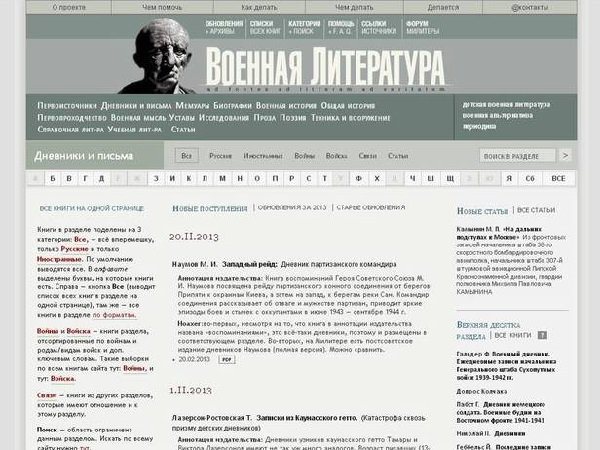
"War Album"
The private photo project “War Album” is a digital archive of photographs from the Second World War and the Great Patriotic War (1939-1945). The goal of the project is to preserve as many wartime photographs as possible in high quality and make them as conveniently accessible as possible. All photographs presented on the site are systematized using categories and tags and are accompanied by detailed text descriptions.
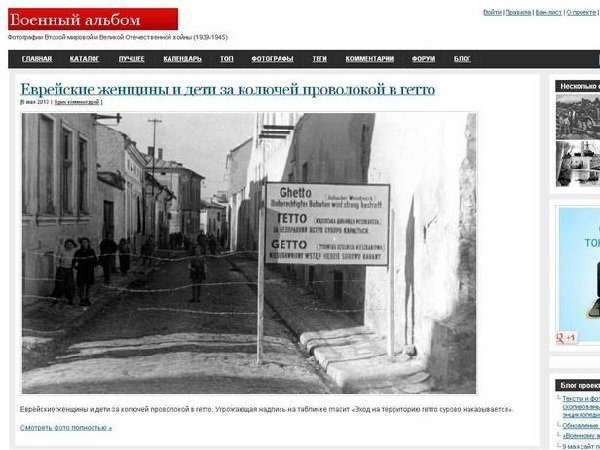
“Family photo chronicles of the Great Patriotic War”
The project “Family Photo Chronicles of the Great Patriotic War” began as the All-Russian photo competition “Family Album”, continued as a volunteer event for the 65th anniversary of the Victory, and then turned into an independent project that received support from the Agency for Strategic Initiatives to promote new projects.
The goal of the project is to perpetuate the memory of the Great Patriotic War by creating an archive (electronic database) of family photographs of war and post-war times. Students from educational institutions are collecting photographic materials from family archives under the guidance of teachers and with the assistance of city and district Veterans Councils.
In addition, anyone can add their own wartime family photographs to the archive. To do this, you need to post photographs in electronic form on the website fotohroniki.ru, accompanying each of them with a brief commentary about the people and events presented in the photo.

"Winners"
The “Winners” project (pobediteli.ru), created for the 60th anniversary of the Victory, is a civil initiative of individuals and companies. The most important part of the project is a search system for lists of WWII veterans, which helps people find each other.
According to the creators of the project, literally from the first day they began to receive letters from site visitors who found their relatives and friends on the list who were considered dead. It turned out that, despite the fact that the war ended more than 60 years ago, not all relatives and friends found each other.
The creators of the project publish requests for searches for WWII veterans. People who find out that someone is looking for them, or their friends, provide the site administration with their contact information. This way, people who are looking for each other can contact directly and finally meet.
Another interesting part of the project is a multimedia map of the war with the memories of participants and archival chronicles. This is an interactive map that clearly presents the entire history of the military operations of the Second World War. Key points are accompanied by additional information with photographs and videos, as well as audio recordings of veterans' memories.
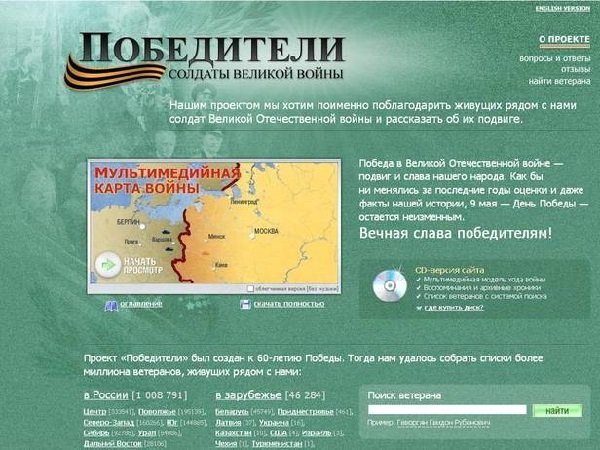
"Victory Calendar"
“Victory Calendar” is a set of thematic bulletins with descriptions of battles, interesting articles from front-line newspapers, stories about the exploits and destinies of individuals, military folklore (songs, poems, anecdotes), photographs and illustrated materials (posters, drawings from newspapers). Today the website presents the newsletters “Rzhev Offensive Operation”, “Defense of the Taman Peninsula” and “Malaya Zemlya MYSKHAKO”.
The idea of the “Victory Calendar” project is to show little-known and unique, previously unpublished materials that convey the versatility of the events of the Second World War and the complex fate of man. The goal of the project is to highlight known historical facts of this period from different angles, to find new factual materials, interesting details of well-known events.
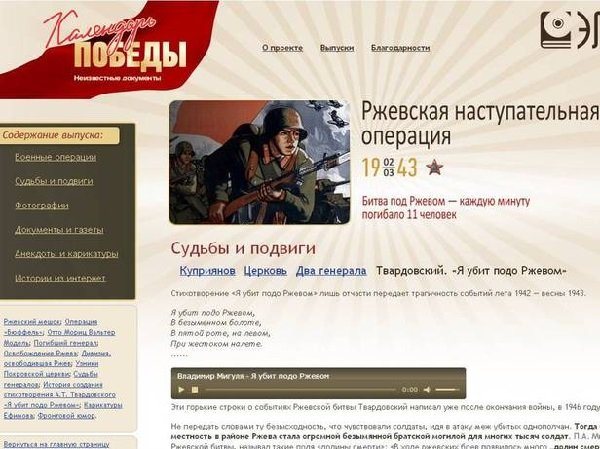
As you can see, on the RuNet there are many interesting resources related to the Second World War that deserve attention, and not only on the eve of Victory Day. And each of us can contribute to preserving the memory of these important pages of our history: find out the fate of our own relatives, help our beloved grandparents find front-line comrades, record a video interview with a veteran living next door, replenish military photo albums with pictures from the family archive, or simply tell your children about the feat of our people in the Second World War. And this is the least we can do to thank the heroes for the Victory.
Source:
therunet.com
SEND:
| Follow @chaskor |
Related articles:
- From an old kettle. Memories and thoughts. Fragments of the Internet diary of a disabled person from World War II.
- The man from the award list.
- “For Zina Tusnolobova!” During eight months of bloody fighting on the Voronezh Front, she carried 123 wounded soldiers and officers from the line of fire.
- The enemy of my enemy is a friend. Soviet posters on the topic of military cooperation between the USSR and its allies in the Anti-Hitler coalition.
- The main thing you need to know about the war. About what people who had to live through it remember very well about the war.
- Riot of the doomed. On February 3, a memorable date passed unnoticed in the Russian media, the round anniversary of the tragedy, which the Nazis at one time called the “Mühlviertel hare hunt.”
- "After a good war..."
- Memory is in law. About history.
- Battle for the War. The past paralyzes movements, but does not drag you back.
- "Young man! What are you doing? From a madhouse? Or from America? . Memoirs of a prisoner of Stalin's camps, one of the first members of the Memorial society, Susanna Pechuro, about the beginning of the war.
battle of Borodino
The general battle began on September 7 (August 26), 1812, early in the morning. Kutuzov successfully positioned his troops, stopping all attempts by the French to attack the army from the flanks. Napoleon had no choice but to throw his main forces head-on into well-fortified positions. The battle lasted 12 hours, there were huge losses on both sides - more than 58 thousand people for the French army and almost 46 thousand people for the Russians.
There were no winners in this battle. But the Russian army proved that it could fight on equal terms with Napoleon’s “invincible” army. Napoleon's confidence in victory over Russia was shaken.
Kutuzov understood that a new battle could completely destroy the army, so in the village of Fili on September 13 he decided to further retreat. I had to leave Moscow.
Collapse of Napoleonic Army
Even before the war, Napoleon claimed that if he took Moscow, he would strike Russia in the very heart. In fact, it was Moscow that defeated Napoleonic army. Having entered the city on September 14, Napoleon's army ceased to exist as a combat unit.
Total robbery and violence against the population turned the Grand Army into a bunch of marauders. The once invincible French army was disintegrating before our eyes; when Napoleon realized this, it was too late. He was trapped.
To save the army, Napoleon sent a letter to Emperor Alexander I with a proposal to make peace. But Alexander did not answer. Then Napoleon realized that he had lost. He had no choice but to leave Moscow. And he gave the order to his troops to leave the city.
The French army's communications lines, stretched over hundreds of kilometers, could not provide the troops with everything they needed; moreover, the fire that raged in Moscow for more than a week destroyed all possible food supplies. Napoleon gave the order to retreat, leaving Moscow; the French army was pulling behind it a huge convoy with looted goods, which greatly affected its maneuverability.
Taking advantage of this, Kutuzov cut off Napoleon's troops from the southern provinces and, with the help of auxiliary troops from the north, forced the French to retreat along the old Smolensk road. Napoleon's army was melting before our eyes, due to the lack of provisions, famine began, constant threats to the Russian army, moving in parallel, forced the French to abandon everything just to move forward faster.
At the end of November, the Great Army that reached the Berezina River was a pitiful sight. There was a complete absence of cavalry, all artillery was abandoned, about 40 thousand people were unarmed, wounded and frostbitten. To avoid complete destruction during the crossing from the attacking Russian army, Napoleon ordered the bridges to be burned, fled, and left the remnants of the army to the mercy of fate.
"Winners"
The “Winners” project (pobediteli.ru), created for the 60th anniversary of the Victory, is a civil initiative of individuals and companies. The most important part of the project is a search system for lists of WWII veterans, which helps people find each other.
According to the creators of the project, literally from the first day they began to receive letters from site visitors who found their relatives and friends on the list who were considered dead. It turned out that, despite the fact that the war ended more than 60 years ago, not all relatives and friends found each other.
The creators of the project publish requests for searches for WWII veterans. People who find out that someone is looking for them, or their friends, provide the site administration with their contact information. This way, people who are looking for each other can contact directly and finally meet.
Another interesting part of the project is a multimedia map of the war with the memories of participants and archival chronicles. This is an interactive map that clearly presents the entire history of the military operations of the Second World War. Key points are accompanied by additional information with photographs and videos, as well as audio recordings of veterans' memories.
The Great Patriotic War - a booklet for parents
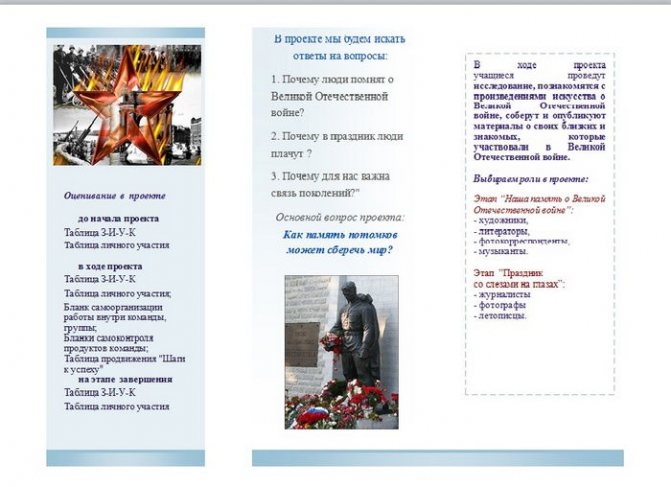
The booklet for parents introduces a summary of the project and answers key questions. During the project, students will conduct research, get acquainted with works, collect and publish materials about the Great Patriotic War.
An example of a student project activity product
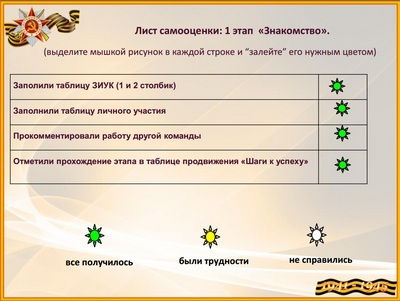
Diary of the “Luchiki” team in Rasskazovo, contents:
- Self-assessment sheet: Stage 1 “Getting to know each other”
- Stage “Memory of the Second World War” and description
- Self-assessment sheet: Stage 2 “Memory of the Second World War”
- Team work at the stage “Memory of the Great Patriotic War”
- Self-assessment sheet: Stage 3 “Celebration with tears in our eyes”
- Self-assessment sheet: stage 4 “Connection of generations”
- Self-assessment sheet: final stage
Thanks to this project, we learned many previously unknown facts about the Great Patriotic War of 1941-1945. It was very interesting for us to study the history of our country not only as part of the educational process, but from additional sources of information, which is what this project is.
Working on the project turned out to be very interesting and educational.
Joint actions and discussions brought together a team of teachers, children and parents. The team shared the knowledge they gained with the whole class, relatives, and others.
Diary of the team "Luchiki"
Interview with veteran Stepanova Galina Sergeevna
War is an essay
Drawing competition “Let there always be sunshine”

Drawing competition “Let there always be sunshine.” The works were completed by our participants and are posted in the center’s gallery.
Formative and summative assessment materials
Materials for formative and summative assessments are presented in the form of various tables and forms. They allow you to evaluate the activities of project participants at each stage. Here are materials for the project dedicated to the 70th anniversary of Victory in the Great Patriotic War.
Table Z-I-U-K
Personal participation table
Form for self-organization of work within a team
Self-assessment forms
Interview preparedness form
Reflection for project participants

